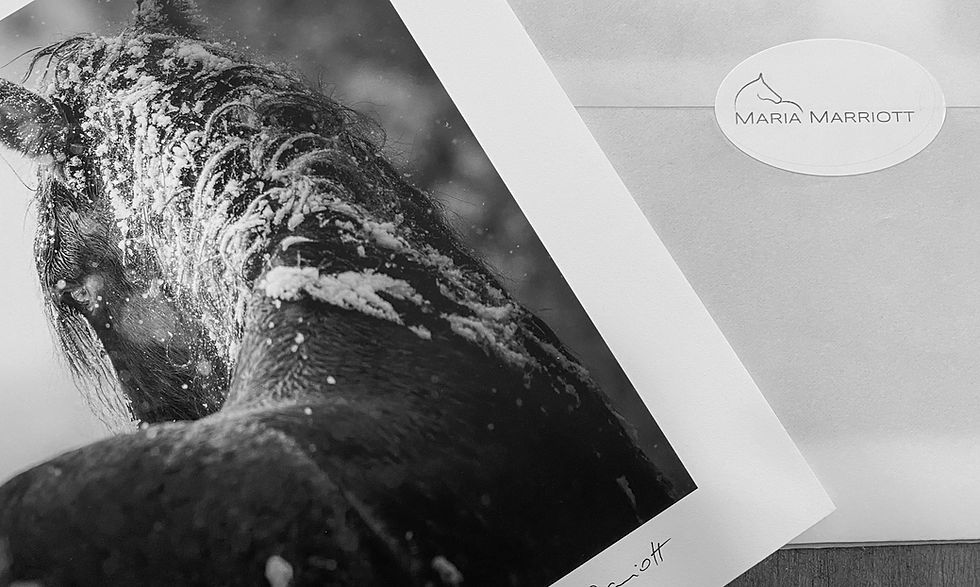Why is Black and White Wild Horse Photography So Compelling?
- Maria Marriott

- Sep 13, 2023
- 4 min read
Updated: Aug 10

Photo Credit: Maria Marriott Photography
“The horse moved like a dancer, which is not surprising. A horse is a beautiful animal, but he is perhaps most remarkable because he moves as if he always hears music.”– Mark Helprin, A Winter’s Tale
From the moment I set eyes on the majestic American mustangs running freely across the vast landscapes of the Western states, I knew I had stumbled upon a world of unparalleled beauty and drama. And I knew that I had to tell their stories through my photography.
Black and white wild horse photography has the remarkable ability to capture the essence of these creatures, focusing attention on their beauty and the landscapes they inhabit. Certain images call for a simple, monochromatic treatment in order to tell the stories in a way that color images simply cannot - thus the reason I have chosen this palette for many of my wild horse artworks.
As my work has become recognized on a larger stage, I’ve found that my initial instinct about portraying the American wild horses in monochrome was validated. Although my portfolio is comprised of both color and black and white images, most of my popular photographs are black and white due to the mood they invoke.
Why Black and White?
There's something enchanting about how monochrome images can encapsulate the raw essence of the American mustangs. In the absence of color, the viewer is drawn into a world where textures, contrasts, and emotions take center stage. The colors are no longer a distraction, allowing total attention on the subject.
Black and white photography possesses a timeless quality and elegance that sets it apart from its colorful counterpart. Stripping away the color allows us to focus on textures, contrast and composition of an image.
Photo Credit: Maria Marriott Photography
A monochromatic image can also evoke a sense of nostalgia and add mystery and depth. It encourages the viewer to use imagination to fill in the missing hues, engaging them in a more immersive and interpretive experience.
Minimalism and Emotion in Wild Horse Photography
As my collectors know, my approach is one of minimalism and emotion. Black and white wild horse photography allows me to distill a scene down to its essential elements.
If I’m portraying, for example, a stallion in the desert under a unique cloud at sunset, reducing the image to monochrome brings out the distinct shapes of the horse and cloud, rather than being distracted by the greens, browns, and yellows of the desert environment. The emotion of the scene is enhanced by creating a contrast between the relative darkness of the landscape and the lightness in the sky.
Photo Credit: Maria Marriott Photography
This minimalistic approach and absence of color allow me to portray a distinct mood, the emotions I experience when observing the mustangs in their natural environment.
Wild Horse Fine Art or Documentary Photograph?
My journey into black and white wild horse photography developed out of my background in photojournalism. Photojournalism involves capturing reality; telling the story of "what is" through a photograph. And much of the wild horse photography commonly available serves to document the reality of the American untamed mustangs and the terrain they inhabit.
Eventually, though, my journey led me to embrace the portrayal of the wild horses through an artistic lens. In my thinking, what makes a photograph "art" is creating perspective and transformation.

Photo Credit: Maria Marriott Photography
In other words, an image is captured or transformed such that it causes a viewer to see things in a different way. To me, that means taking a technically perfect photograph and using the light, composition, and color scheme (usually monochromatic) to tell the story, to create the perspective I want the viewer to
consider.
When you explore my wild horse fine art collections, my goal is to encourage you to feel as if you are stepping into a realm of realism transformed into art; a gallery of thought-provoking stories with a touch of the mythic; stirring emotions and a reflection of the American spirit; and rugged beauty in all its wildness.
I take immense pride in adhering to museum-quality standards for all my wild horse artwork, using archival materials to ensure that every piece stands the test of time, so that each becomes a visual narrative in your special space.

Photo Credit: Maria Marriott Photography
Advocacy through Wild Horse Art
Beyond creating photographic art, my passion involves helping to bring attention to the challenges these horses face in preserving their freedom. A portion of the proceeds from each sale goes to non-profit organizations dedicated to the cause of wild mustangs and the benefits of equine therapy.
Portraying the heritage of the American wild horses through equine artwork is the way that I can best contribute, working with several organizations dedicated to this cause. Wild horse fine art photography has become for me a means of storytelling, advocacy, and preservation for those that need a human voice to advocate for them.
I invite you to visit my online gallery, Maria Marriott Photography, to view more black and white wild horse photography and read the stories of life in the wild. And please feel free to reach out anytime. Would love to her from you.






Comments